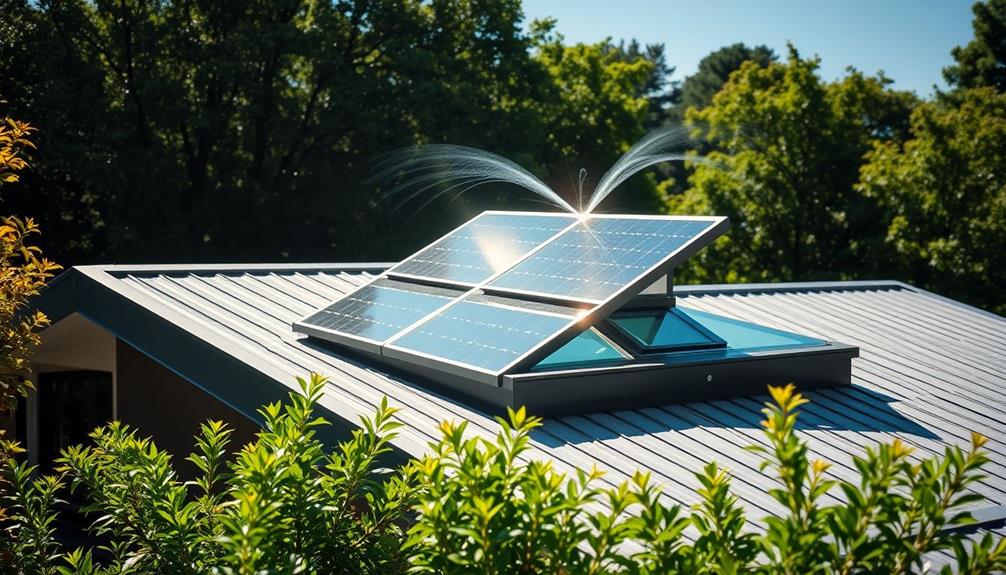Solar-powered roof vents harness sunlight to cool your home efficiently and sustainably. They lower attic temperatures by up to 40°F, which can enhance your HVAC system's performance and reduce mold growth. With minimal maintenance and no ongoing operational costs, you can save over $200 annually on electricity bills. Installation typically takes just a few hours, and various financing options are available, including federal tax credits. By improving ventilation and air quality, solar vents can make your home more comfortable. If you're curious about the best options and considerations for installation, there's more to explore.
Key Takeaways
- Solar-powered roof vents use photovoltaic panels to cool attics, reducing temperatures by up to 40°F and enhancing HVAC efficiency.
- They operate independently using renewable energy, promoting sustainability and reducing ongoing operational costs.
- Installation costs range from $300 to $800, with potential annual savings on electricity bills exceeding $200.
- Federal tax credits can offset installation expenses, providing up to 30% savings for systems installed from 2022 to 2032.
- Regular maintenance is minimal, ensuring longevity of around 25 years and reliable performance in improving indoor air quality.
What Are Solar-Powered Roof Vents?
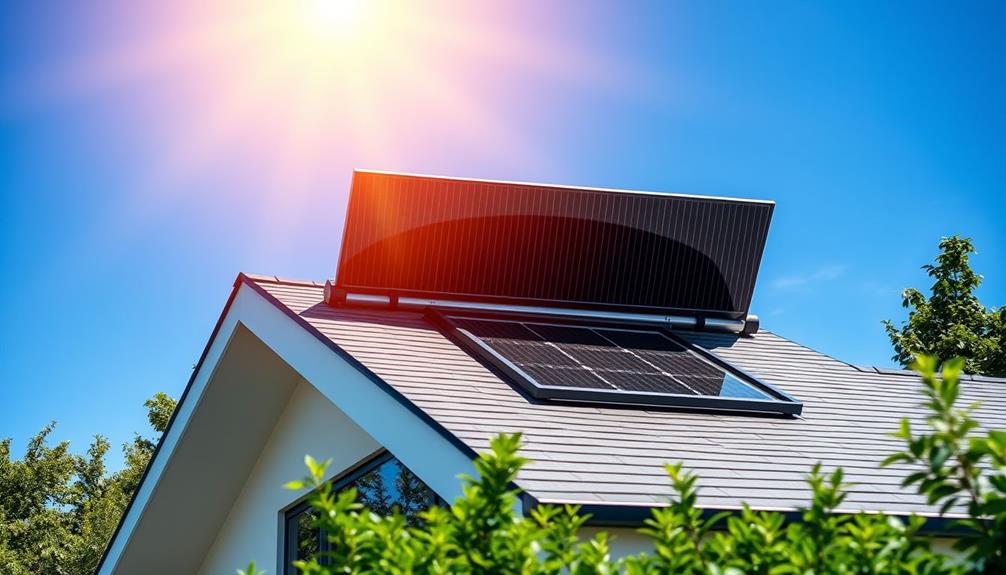
Solar-powered roof vents are innovative devices that harness sunlight to keep your attic cool and dry. These vents utilize photovoltaic (PV) panels to convert sunlight into electricity, powering attic fans that actively expel hot air and moisture. By lowering attic temperatures by up to 40°F, they enhance the efficiency of your HVAC systems, helping you maintain a comfortable home environment.
Implementing such eco-friendly solutions aligns with the principles of design thinking for business, which emphasizes innovation and sustainability.
One of the best aspects of solar-powered roof vents is their eco-friendly nature. Operating without traditional electricity, they incur no ongoing operational costs, making them a cost-effective solution for home cooling.
Installation is straightforward, requiring minimal tools and expertise, so you can easily set them up on various roof types.
With an average lifespan of around 25 years, the solar panels used in these vents guarantee long-term performance and sustainability. Choosing solar-powered roof vents not only helps in reducing your energy bills but also contributes to the use of renewable energy, making your home more environmentally friendly.
How Do They Work?
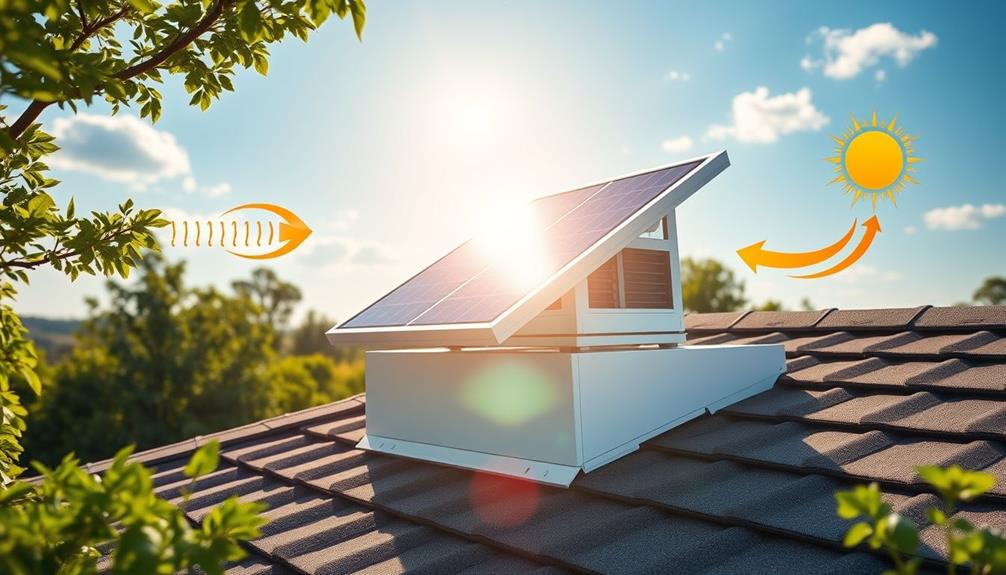
How do these innovative vents keep your attic cool? Solar-powered roof vents utilize photovoltaic (PV) cells to convert sunlight into energy, which powers an attic fan. This fan actively pulls hot air out of your attic, greatly enhancing ventilation. When the temperature rises, a built-in thermostat activates the fan, typically between 72°F and 83°F, ensuring efficient operation during hot days.
| Feature | Description |
|---|---|
| Energy Source | Uses solar energy to power the attic fan |
| Temperature Control | Activates fan based on preset temperatures |
| Humidity Management | Reduces humidity levels to prevent mold growth |
Advantages of Solar Vents

One of the standout benefits of solar vents is their ability to drastically reduce attic temperatures, making your home more comfortable during sweltering months. By using solar power, these energy-efficient solar attic fans can lower temperatures by up to 40°F, which means you'll rely less on air conditioning. This not only leads to savings on your electricity bills—often exceeding $200 annually—but also helps improve indoor air quality by decreasing humidity levels.
Additionally, just as investing in a Gold IRA provides a hedge against economic downturns, solar vents offer a sustainable solution that shields your home from the financial strains of high energy costs.
With improved attic ventilation, you can prevent mold growth and extend the lifespan of your roofing materials, protecting your investment. Plus, since solar vents incur no operating expenses or significant maintenance costs, they offer a cost-effective solution compared to traditional electric fans, which require ongoing electricity charges.
Using solar-powered roof vents also allows you to reduce your carbon footprint, promoting sustainable living practices. By harnessing clean, renewable energy, you're contributing to a healthier environment for future generations.
Cost and Installation Overview
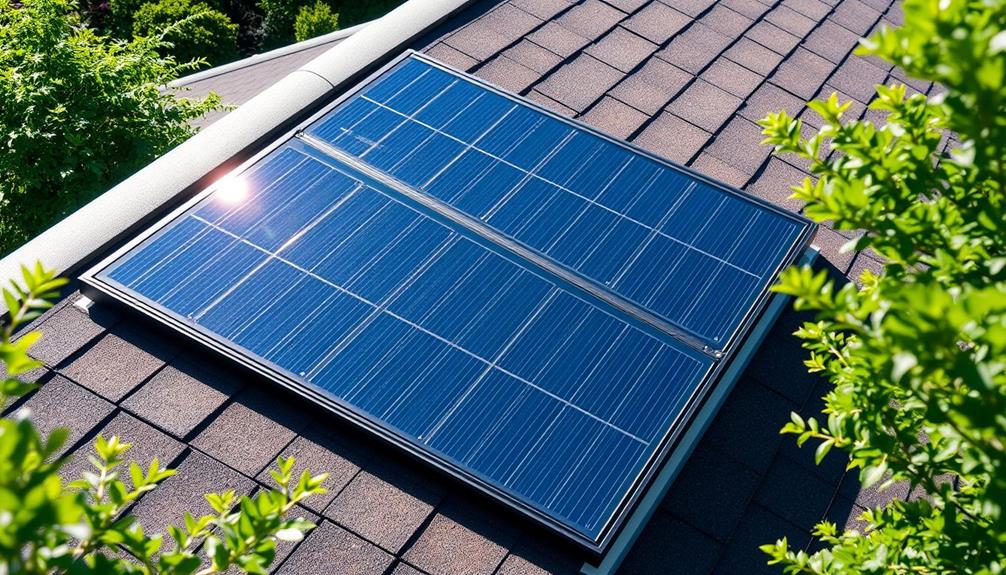
When considering a solar-powered roof vent, you'll find the installation costs typically range from $300 to $800, depending on your chosen model.
Additionally, investing in energy-efficient solutions like solar ventilation can be part of a broader strategy for long-term financial savings and environmental benefits, similar to diversification of retirement portfolio in financial planning.
You can often complete the installation in just a few hours with the help of professionals.
Plus, financing options and potential tax credits can help make this eco-friendly upgrade more affordable for you.
Installation Cost Breakdown
While considering the installation of a solar-powered roof vent, it's important to understand the associated costs. The initial installation costs for these vents typically range from $300 to $800, depending on the model and the complexity of the installation.
This investment can pay off quickly, as you might see energy savings exceeding $200 annually on your electricity bills. With peak performance during peak sunlight hours, these vents can also enhance your home's energy efficiency, contributing to your overall renewable energy goals.
Installation generally takes only a few hours, and since solar-powered roof vents have minimal moving parts, they require little maintenance over time.
However, if your vent is connected to a battery or grid, professional installation may involve some electrical work, ensuring proper sealing to avoid leaks.
It's also worth looking into any available rebates or incentives in your area, as these can help offset those initial installation costs.
With a solid return on investment (ROI) expected within 3 to 5 years, a solar-powered roof vent not only enhances your home's ventilation but also contributes to long-term energy savings.
Financing Options Available
Understanding financing options can greatly ease the upfront costs associated with installing a solar-powered roof vent. Typically, installation costs for a solar attic fan range from $300 to $800, which is manageable for many homeowners focused on energy efficiency.
By incorporating advanced technology, as seen in the top-rated heat pumps, these systems can greatly enhance your home's energy efficiency. To help offset these upfront costs, many regions offer incentives or rebates, making this investment even more appealing.
Additionally, federal tax credits currently stand at 30% for solar installations completed between 2022 and 2032. This considerable tax credit enhances the financial attractiveness of financing options for your solar attic fan.
Companies like Lee Company provide flexible financing plans that allow you to spread the installation costs over time, ensuring it fits your budget.
The long-term savings on energy bills can be remarkable. With reduced cooling costs, you could save over $200 annually, providing a potential return on investment (ROI) within just 3 to 5 years.
Performance and Maintenance Tips
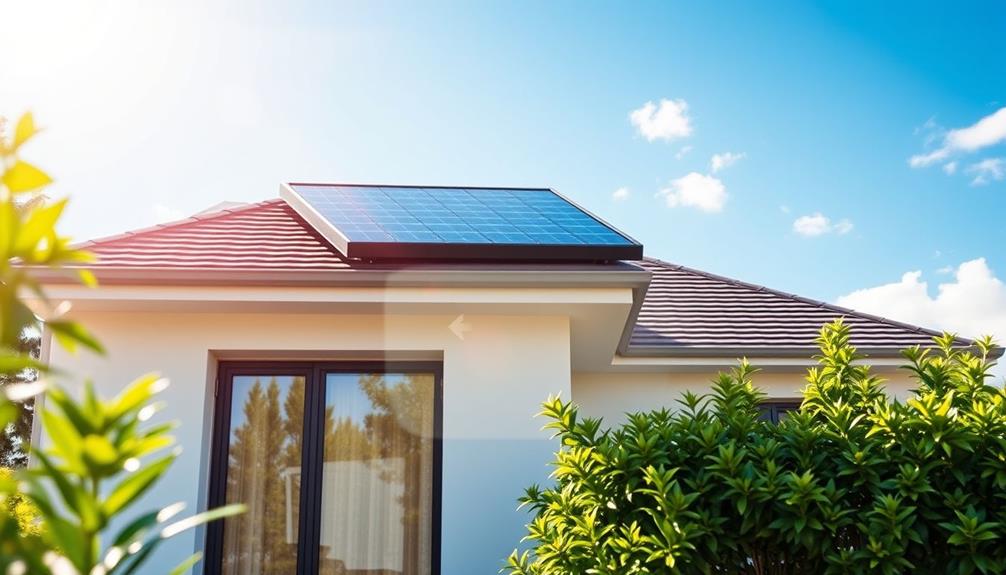
To guarantee your solar-powered roof vent performs at its best, regular maintenance is essential. Start by cleaning the solar panels periodically to verify they're free from dirt and debris. This simple step can considerably enhance the energy efficiency of your attic fan, allowing it to operate effectively.
Additionally, consider the benefits of natural remedies for a holistic approach to home comfort. Next, inspect the vent for any blockages that could obstruct airflow. This includes checking the surrounding area and verifying nothing is restricting the vent's intake or exhaust.
Additionally, familiarize yourself with the temperature sensors integrated into your solar-powered vent. These sensors automatically activate the fan when attic temperatures exceed preset thresholds, promoting consistent airflow and moisture control.
It's also wise to check the connections and wiring periodically to prevent any potential issues. Remember, the average lifespan of solar panels in these vents is around 25 years, making them a long-term investment in your home's comfort.
Comparison With Traditional Vents
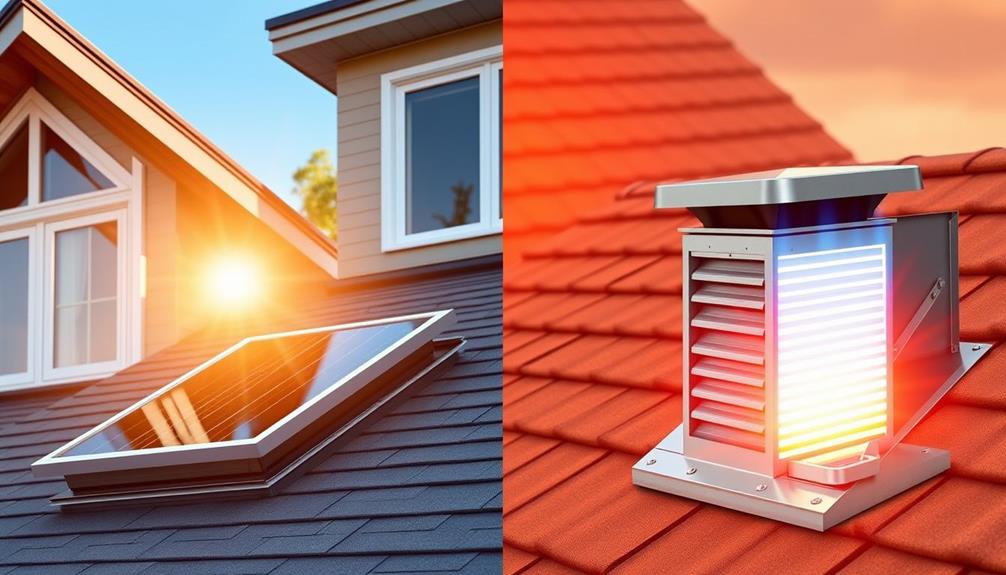
When comparing solar-powered roof vents to traditional vents, you'll find considerable advantages in efficiency and cost-effectiveness.
Solar vents actively draw hot air out of your attic using solar energy, making them far more effective in extreme heat than traditional vents, which rely on passive airflow. This means that on hot days, you can keep your attic temperature considerably lower—by up to 40°F—enhancing your entire HVAC system's efficiency.
Additionally, utilizing renewable energy sources for home improvements can align with sustainable living practices, such as easy composting, which reduces waste and benefits the environment.
One of the biggest benefits of solar vents is that they operate independently without needing electrical power. This not only saves you from ongoing operating costs but also helps reduce your energy bills.
In contrast, traditional vents may struggle during low airflow conditions, making them less reliable when you need ventilation the most.
Maintenance is another area where solar vents shine. With fewer moving parts, they require minimal upkeep compared to traditional vents, which may need more frequent maintenance due to their reliance on passive airflow.
Financial Incentives and Savings
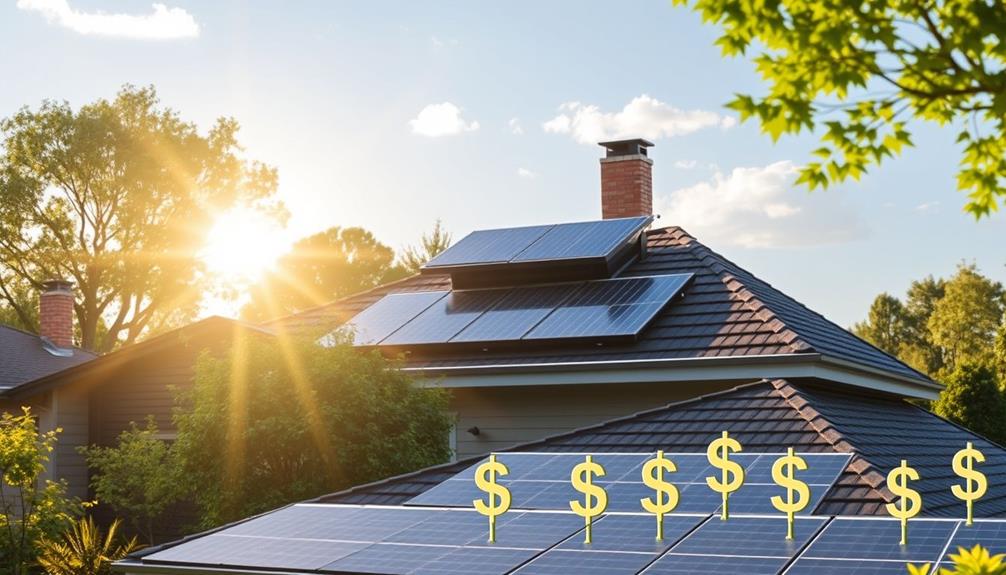
If you're considering solar-powered roof vents, you'll be glad to know there are significant financial incentives available.
With a 30% federal tax credit and potential local rebates, the upfront costs can be more manageable.
Additionally, implementing energy-efficient solutions can help you stick to your budget while reducing your overall energy expenses.
Over time, you could save more than $200 a year on your energy bills, making this a smart investment for your home.
Tax Credit Benefits
Investing in a solar-powered roof vent can lead to significant financial benefits, especially with the current federal tax credit of 30% for installations made from 2022 to 2032.
This tax credit greatly reduces the upfront cost of solar attic fans, making them an attractive option for homeowners like you. Additionally, maximizing your tax savings can enhance your overall financial strategy, much like diversifying your investments with Gold IRA options.
By taking advantage of this federal tax incentive, you'll not only lower your initial investment but also enhance your home's energy efficiency.
In Tennessee, where median monthly electricity bills hover around $160, the savings from using solar attic fans can exceed $200 annually.
This means that the cost of installation can be offset over time, thanks to lower utility expenses. Plus, local incentives may also be available, further enhancing your savings on energy costs.
Long-Term Savings
Solar-powered roof vents offer homeowners a compelling opportunity for long-term savings on energy costs. By installing solar attic fans, you can considerably reduce attic temperatures, which in turn boosts your HVAC efficiency. This energy-efficient solution not only lowers electricity bills but also aligns with financial incentives for renewable energy.
In Tennessee, homeowners can save over $200 annually on electricity bills, making this investment not just eco-friendly but financially wise.
While initial installation costs for solar-powered roof vents range from $300 to $800, the potential return on investment (ROI) typically falls within 3 to 5 years due to the notable energy savings. With Tennessee ranking 6th in the U.S. for the highest electric bills, the impact of these energy-efficient solutions can be substantial.
Furthermore, don't overlook the financial incentives available, like federal tax credits that can reach up to 30% for systems installed from 2022 to 2032. These tax credits, coupled with potential rebates, can help offset those upfront installation costs, enhancing your long-term savings.
Installation Cost Assistance
When considering the installation of a solar-powered roof vent, many homeowners find that various financial incentives can greatly ease the initial cost burden.
Here are three key ways to reduce your installation costs:
- Federal Tax Credits: You could qualify for a tax credit of 30% for solar systems installed from 2022-2032, lowering your upfront expenses markedly.
- Rebates: Local utilities may offer rebates for energy efficiency upgrades, which can further offset costs.
- Flexible Financing: Many providers offer financing plans that make it easier to manage installation costs without upfront payments.
Investing in a solar-powered roof vent not only boosts your home's energy efficiency but also yields a solid return on investment.
In Tennessee, for instance, homeowners can save over $200 annually on energy bills, leading to a payback period of just 3 to 5 years.
Plus, once installed, these vents require minimal maintenance, ensuring lower long-term costs.
Seeking professional consultations can help you navigate these financial incentives and maximize your savings, making a solar-powered roof vent a smart and affordable choice for your home.
Factors for Choosing a Solar Vent
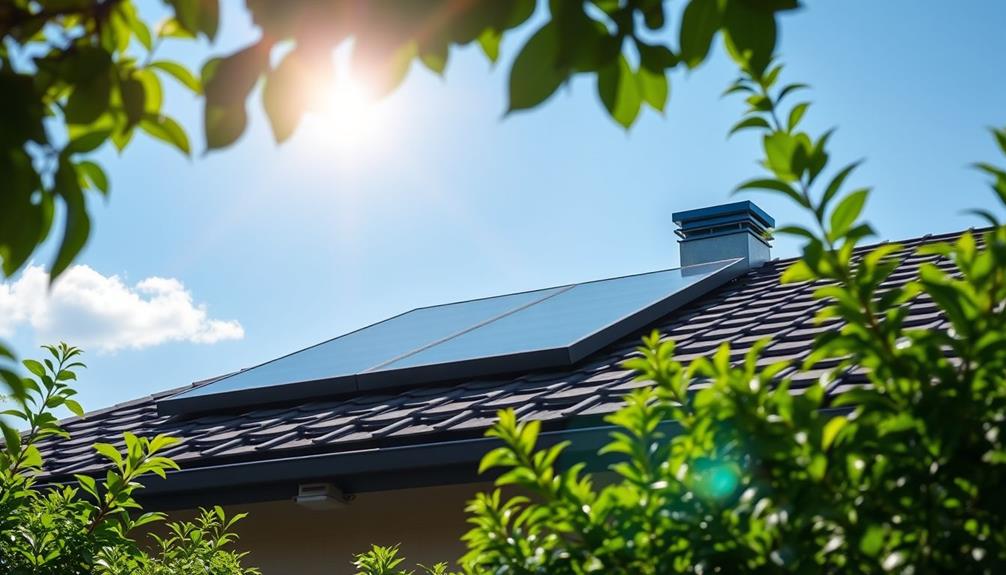
Choosing the right solar vent for your attic involves several key factors. First, consider the size of your attic. The capacity of the solar vent must match the volume of air that needs circulation for effective cooling and ventilation. Next, verify sufficient sun exposure on the roof; the efficiency of the solar panel directly impacts the vent's performance. Ideally, it should be positioned in a spot with minimal shading.
Additionally, evaluate your local climate and humidity levels, as these influence the ventilation needs and the effectiveness of your solar vents. Extreme temperatures can greatly affect performance. It's also crucial to assess the number of existing vents in your attic, as this will help determine the airflow dynamics and the best size and number of solar vents needed. Finally, decide between roof-mounted or gable-mounted solar vents based on your attic design, as proper positioning enhances sun exposure and air circulation.
| Factor | Considerations | Impact |
|---|---|---|
| Attic Size | Match vent capacity with air volume | Effective cooling |
| Sun Exposure | Minimize shading for solar panel efficiency | Performance boost |
| Local Climate | Assess temperature and humidity | Ventilation effectiveness |
| Existing Vents | Evaluate airflow dynamics | Best performance |
| Mounting Type | Choose roof or gable mounted based on design | Maximized air circulation |
Professional Installation Benefits
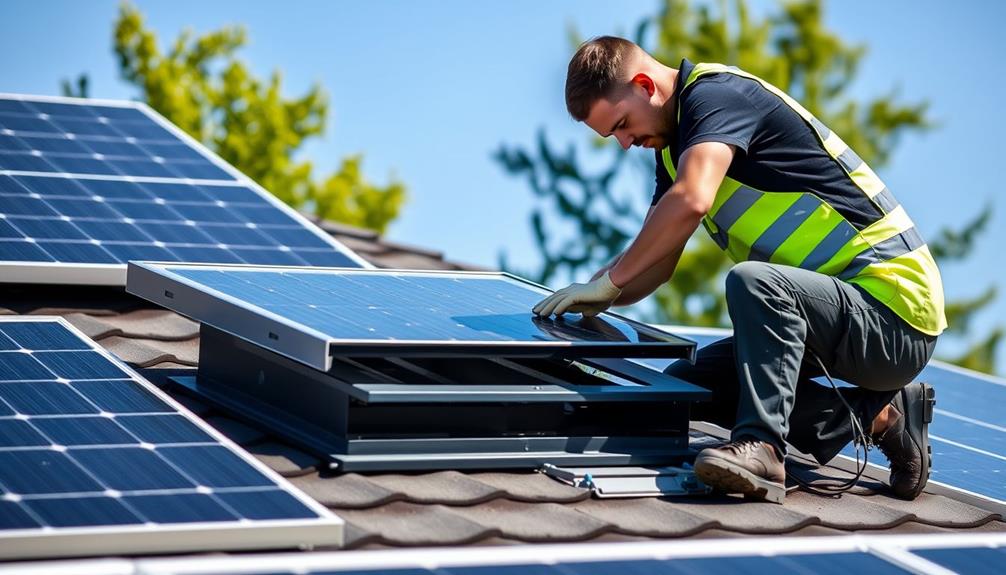
Properly selecting a solar vent is just the start; verifying it's installed correctly can greatly impact its performance. Here's why you should consider professional installation:
- Optimal Performance: Expert technicians verify proper placement and alignment of the solar panel, allowing for maximum sunlight exposure. This guarantees that your vent operates at peak efficiency.
- Tailored Solutions: Professionals assess your attic's specific conditions and recommend the right fan capacity, verifying effective air circulation that meets your home's unique needs.
- Quick and Efficient Process: Professional installations are typically completed in just a few hours, minimizing disruption to your household while allowing you to enjoy immediate benefits.
Using certified contractors for installation not only enhances safety but also reduces the risk of potential issues like leaks or operational failures that may arise from improper installation.
Additionally, qualified installers offer valuable insights into maintenance requirements and best practices, helping you extend the lifespan and efficiency of your solar vent system.
Final Thoughts on Solar Roof Vents
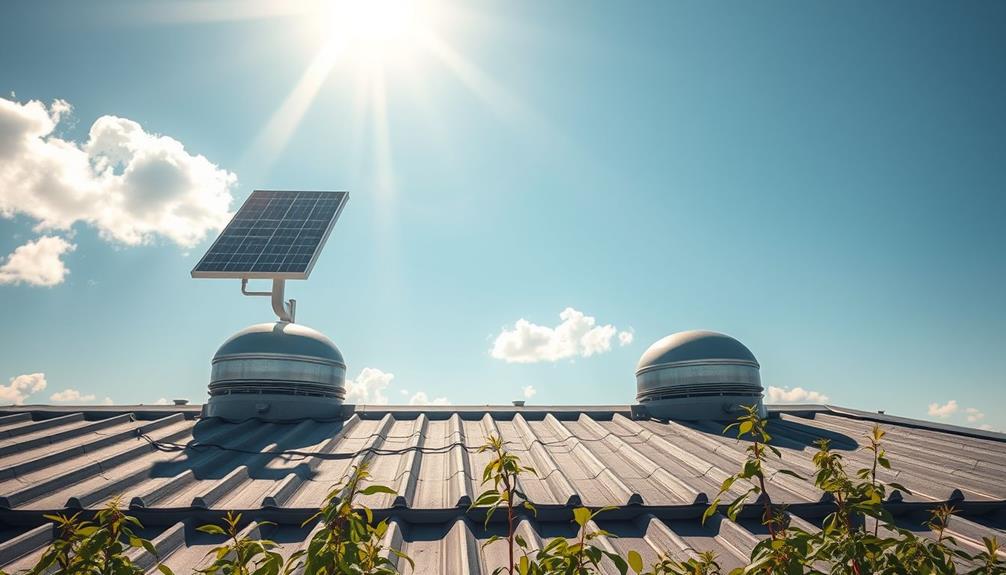
As you consider enhancing your home's energy efficiency, solar-powered roof vents emerge as a smart investment. These solar attic fans harness energy from the sun, effectively reducing attic temperatures by up to 40°F. By keeping your attic cooler, solar-powered roof vents can help lower your overall energy costs by reducing the strain on your air conditioning system. Additionally, a solar roof fan can extend the life of your roof by preventing the buildup of moisture and reducing the risk of mold and mildew. With the potential for long-term energy savings and the added benefit of improving the overall health of your home, investing in solar-powered roof vents is a wise decision for any homeowner.
This notable drop not only improves your overall home cooling efficiency but also enhances your indoor environment by reducing hot air and moisture buildup, which can lead to mold growth.
The average return on investment (ROI) for these ventilation products typically materializes within 3 to 5 years, allowing you to save more than $200 annually on electricity bills.
With minimal maintenance and a lifespan of around 25 years, solar-powered roof vents provide a long-term solution to your ventilation needs.
Additionally, the financial appeal is further heightened by federal tax credits of up to 30% for solar installations, available for systems installed between 2022 and 2032.
By choosing solar roof vents, you're not just investing in your home; you're also committing to a cleaner, healthier future.
Frequently Asked Questions
Are Solar-Powered Roof Vents Worth It?
Yes, solar-powered roof vents are worth it. They reduce attic temperatures, enhance HVAC efficiency, and can save you money on energy bills. Plus, you might qualify for tax credits, increasing your return on investment.
Do Solar Attic Fans Help Cool Your House?
Oh sure, if you think hot air's a great houseguest, ignore solar attic fans! But if you want to cool your home efficiently and save money, yes, they definitely help by reducing attic heat and humidity.
Does Having Solar Panels on Your Roof Keep Your House Cooler?
Yes, having solar panels on your roof can keep your house cooler. They reduce attic temperatures considerably, minimizing heat buildup and enhancing your home's comfort. Plus, they lower energy bills by easing your HVAC system's workload.
What Does a Solar Roof Vent Do?
Imagine your attic as a sauna. A solar roof vent actively circulates air, expelling hot air and replacing it with cooler outside air, keeping your home comfortable and preventing moisture buildup. Isn't that smart?
Conclusion
In conclusion, solar-powered roof vents are a smart, eco-friendly solution to keeping your home cool while reducing energy costs. Did you know that homes with solar ventilation can reduce attic temperatures by up to 30 degrees Fahrenheit? This not only enhances your comfort but also extends the lifespan of your roof. By investing in a solar vent, you're not just improving your home; you're contributing to a sustainable future. It's a win-win for both you and the planet!
